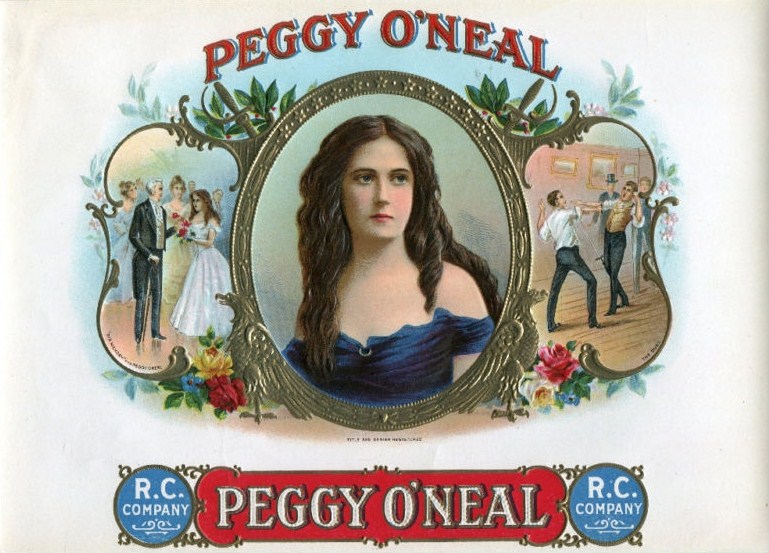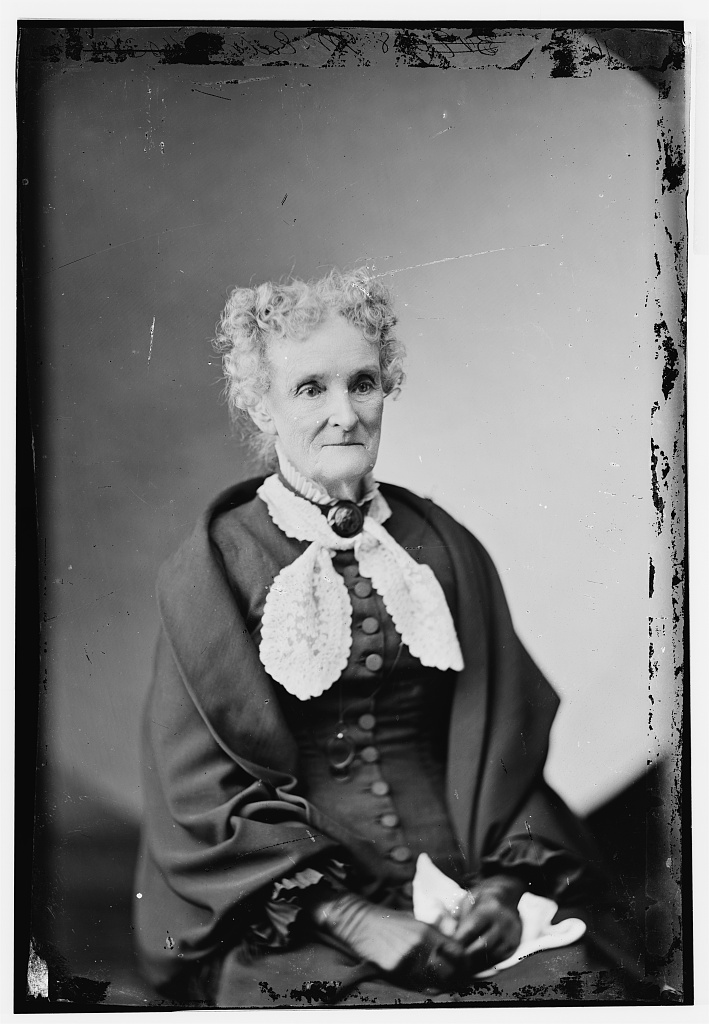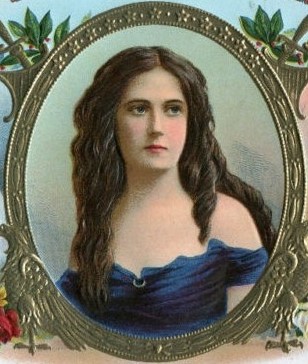A single line in USS Constitution’s logbook noted the death of purser John B. Timberlake on April 2, 1828, while the ship was at anchor in Port Mahon, Minorca, as part of the Mediterranean Squadron. The 50-year-old officer suffered from asthma, had been sick for a while, and died presumably of pulmonary disease and possibly tuberculosis. The next day he was buried on the island.
John Timberlake’s death was sadly unremarkable, but proved to be historically consequential. Nine months after his death, his widow, Margaret O’Neale, married Senator John Henry Eaton, who became President Andrew Jackson’s Secretary of War. For the next two years, Washington society, governed by the wives of powerful cabinet members and legislators, ostracized Margaret Eaton and, by extension, her husband to the point of creating a political rift and scandal that eventually led to the dissolution of Jackson’s cabinet.
Margaret’s short time before remarrying violated the strict social protocols of the era, which dictated that a woman was not to remarry for at least a year after her husband’s death. By itself, this moral breach may have been overlooked, but rumors about Margaret’s background and her relationship with John Eaton were already the subject of whispers among the D.C. gossips. Combined with the circumstances of John Timberlake’s career and death at sea, and Andrew Jackson’s combustible tendency to view every conflict as a personal attack, the whispers turned into a firestorm of lurid public accusations that crippled Jackson’s administration. By April 1831, John Eaton and several other cabinet members were forced to resign in an effort to restore some harmony to the administration.
The origins of these events began with John Timberlake’s introduction to Margaret O’Neale in 1816. At the time, John, 39, was struggling under financial stress, and Margaret, 16, was the outgoing daughter of a Washington, D.C. innkeeper. William O’Neale’s Franklin House had long been a popular boarding house for an array of legislators when they were in town, and Margaret had grown up there. Despite their age difference, Margaret O’Neale and John Timberlake fell in love quickly, and Margaret’s father consented to a marriage.

On two occasions serving on different ships during the War of 1812, John Timberlake was left holding the bill at the end of the voyage. He served as purser on board USS United States during its victory over HMS Macedonian in October 1812. The ship returned to a hero’s welcome in New York, which included a celebratory dinner ashore that the entire crew was allowed to attend. A number of the crew who owed more than they had earned on the voyage took advantage of the opportunity to desert the ship and skip out on the money they owed. As a result, John was left in arrears.
In January 1815, John was serving as the purser on board USS President as it attempted to break out of the British blockade of New York harbor. While fleeing the British squadron, President‘s crew began dumping material overboard to lighten their load. Among the items tossed overboard were the purser’s personal stores. When President was captured by HMS Endymion, John also lost his accounting records detailing what each sailor on board owed him. After the crew returned to shore, John was ordered to settle up payments. Without records to prove who owed what, he was forced to make full payment and take the loss himself.
The combination of these events left John Timberlake in a deep financial hole when he met Margaret O’Neale in 1816. The couple settled in Washington, D.C., adjacent to William O’Neale’s Franklin House, where John opened a store in hope of recovering his finances. It was not successful.
In 1818, the couple met John Henry Eaton, a young senator from Tennessee who began staying at the Franklin House regularly. John Eaton and John Timberlake became friends, and after Purser Timberlake confided to Senator Eaton about his ongoing financial troubles, John Eaton sponsored a petition to the Senate Committee on Naval Affairs in 1820 to provide some restitution to John Timberlake for his war losses. The committee supported his appeal for restitution resulting from USS United States‘ crew desertion because the circumstances were outside of his control, but they denied his request related to his losses as purser on HMS President. In their report, committee members argued that John Timberlake was responsible for the loss of his private stores, and the Navy could not serve as an insurer against those losses. Despite the committee’s partial support, the petition was denied in total by the full Senate. Timberlake got nothing.
With his failed appeal to Congress and his failed store in Washington, John Timberlake returned to the Navy as a purser in 1822. In his absence, John Henry Eaton continued to stay at the Franklin House, and even assisted the family when the house began to struggle financially. Margaret worked at the Franklin House and socialized with John Eaton. The sight of her escorting him to social events around town set the wheels of gossip in motion.
In the early 19th century, women in genteel society were expected to be docile, ignorant, and separate from the male world. Margaret’s active participation in the male-dominated culture of the Franklin House was considered inappropriate. As the daughter of an Irish innkeeper, Margaret was also seen by some as a lower class servant trying to become a lady of the upper class, a further transgression of unwritten societal rules.
John Timberlake, however, appeared to appreciate John Eaton’s support of Margaret and her family. He provided John Eaton with power of attorney and consented to Margaret socializing with him. In 1824, John Timberlake was appointed purser of USS Constitution and prepared for another extended period away in the Mediterranean. Meanwhile, rumors about him began entering into the local gossip, including insinuations that Margaret’s behavior led him to drink and drove him away.
By the time John Timberlake died in April 1828, Margaret had not seen him in two years. He had been home only a few times in the previous years since rejoining the Navy. In the meantime, John Eaton and Margaret had clearly developed an affection for each other. Rumors quickly spread in Washington that John Timberlake had committed suicide because he was aware of his wife’s purported affair with John Eaton.
John Eaton and Margaret Timberlake married in January 1829, but Washington society wanted nothing to do with them. President Andrew Jackson, who suffered similar slanders about his own wife, Rachel, steadfastly supported the Eatons. After taking office in March of that year, Jackson appointed John Eaton as Secretary of War. Despite Eaton’s role as a cabinet member, the women of Washington society still refused to accept Margaret Eaton. The Eatons remained isolated and uninvited to any of Washington’s social events.
In his book, The Petticoat Affair, John Marszalek argues that the wives of Washington’s politicians saw themselves as the protectors of morality in 19th century American society. Allowing Margaret Eaton into the fold would have defied their values and, in their minds, threatened the dissolution of society. Margaret did not behave as women were expected to, and therefore had to be shunned. Despite appeals from some of their husbands to make peace, these women exerted their societal authority in rejecting Margaret Eaton.
Andrew Jackson, however, did not recognize the social component of this conflict, nor the women’s control of it. In Jackson’s mind, his political opponents rejected the Eatons in order to thwart his presidential administration. This only strengthened his support of Eatons, but it also mobilized his opposition and turned the conflict into a political feud. John Eaton resigned, along with other cabinet members and Vice President John Calhoun, whose wife, Floride, had led the opposition to Margaret Eaton.
John Eaton eventually returned to the Senate and later served as Governor of Florida and Ambassador to Spain, with Margaret and their children by his side. While in Spain, the family visited John Timberlake’s grave on Minorca. The couple retired to Washington where John Eaton died in 1856 at age 66. Margaret was left with Eaton’s substantial fortune, but lost it all when she married a young Italian dance instructor who fleeced her. She died in poverty in 1879.

The Author(s)
Carl Herzog
Public Historian, USS Constitution Museum
Carl Herzog is the Public Historian at the USS Constitution Museum.
